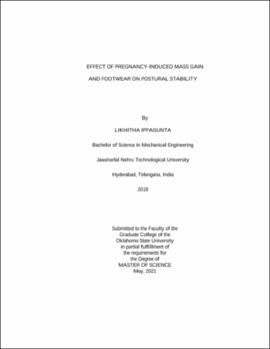| dc.contributor.advisor | Azoug, Aurelie | |
| dc.contributor.author | Ippagunta, Likhitha | |
| dc.date.accessioned | 2021-09-24T13:58:03Z | |
| dc.date.available | 2021-09-24T13:58:03Z | |
| dc.date.issued | 2021-05 | |
| dc.identifier.uri | https://hdl.handle.net/11244/330924 | |
| dc.description.abstract | Pregnancy induces tremendous changes in the body, which increases the risk of falling. Falls are rarely as costly as when they happen during pregnancy, leading to tremendous healthcare, emotional, and societal costs. More than one in four women (27%) fall at least once during pregnancy. Despite overwhelming statistics, there is a dearth of interventions to minimize the risk of falling amongst pregnant women. Our goal was to quantify the effect of pregnancy-induced mass gain and footwear on postural stability throughout pregnancy, as a first step towards a deeper understanding of pregnancy-specific optimal postural strategies. Our main hypothesis was that both footwear and pregnancy mass affect postural stability. | |
| dc.description.abstract | Postural stability was assessed on ten young healthy non-pregnant women and pregnancy was simulated by adding localized weights. Measurements were performed during four sessions (not pregnant, first, second, and third trimesters) wearing five types of footwear in randomized order: flats, sports, low heels, and sports and low heels with ankle brace. The center of pressure (COP) was determined for each instant in time and 22 COP-based postural stability indices (15 temporal and 7 spectral) were computed. The effect of pregnancy-induced mass gain and footwear on each index was assessed using repeated measures ANOVA. | |
| dc.description.abstract | Pregnancy-induced mass gain and footwear have an influence on the postural stability of healthy young female subjects, independently of all other pregnancy-induced physical, hormonal, and psychological changes. Results demonstrated a decrease in mediolateral postural stability with mass gain and footwear such as heels. Ankle braces worn with sport shoes seem to increase postural stability. The decrease in postural stability is detected by a decrease in postural sway, due to a tighter postural adjustment and a rigidification of the posture. This rigidification of the posture results from muscle contraction, which would lead to muscle fatigue if performed continuously during a pregnancy. | |
| dc.description.abstract | This study paves the way for a deeper understanding of postural strategies adopted by pregnant women while wearing different footwear, and thus for the development of efficient fall-avoidance strategies. | |
| dc.format | application/pdf | |
| dc.language | en_US | |
| dc.rights | Copyright is held by the author who has granted the Oklahoma State University Library the non-exclusive right to share this material in its institutional repository. Contact Digital Library Services at lib-dls@okstate.edu or 405-744-9161 for the permission policy on the use, reproduction or distribution of this material. | |
| dc.title | Effect of pregnancy-induced mass gain and footwear on postural stability | |
| dc.contributor.committeeMember | Hausselle, Jerome | |
| dc.contributor.committeeMember | Xiang, Yujiang | |
| osu.filename | Ippagunta_okstate_0664M_17151.pdf | |
| osu.accesstype | Open Access | |
| dc.type.genre | Thesis | |
| dc.type.material | Text | |
| thesis.degree.discipline | Mechanical and Aerospace Engineering | |
| thesis.degree.grantor | Oklahoma State University | |
